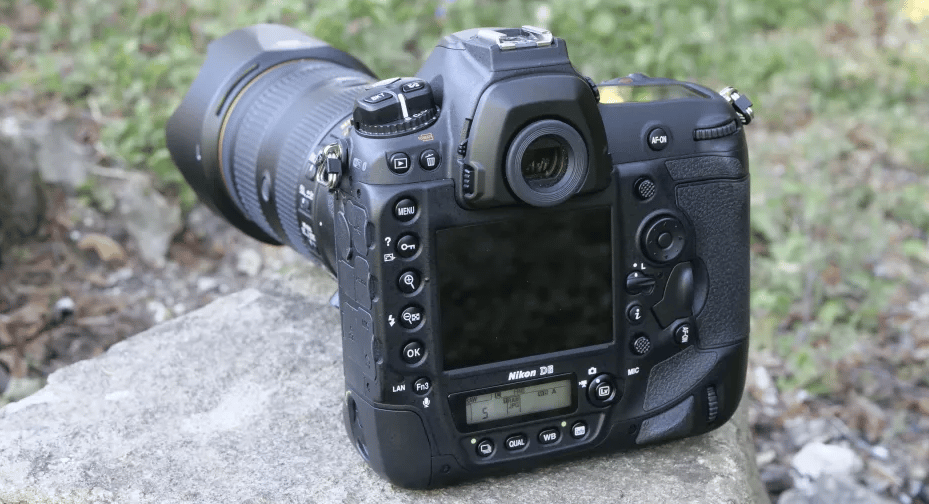When you purchase through links on our site, we may earn an affiliate commission. Here’s how it works.
Nikon D6 Review
Sitting at the top of Nikon’s impressive camera lineup is the D6.
Admittedly, the D6 is a total overload for the average photographer, but it’s perhaps a wise buy for anybody with a massive budget who likes to capture sport, wildlife, or other moving subjects.
Equipped with the same 20.8 Megapixel image sensor as its predecessor, the D5, the Nikon D6 is in many aspects an upgrade.
Moreover, it has some impressive upgrades such as a better autofocus system, better processor, built-in Wi-Fi, and compatibility with CFExpress cards.
Individually most of these upgrades might feel a bit underwhelming, but collectively they make an impressive overhaul.
What’s more, they are housed in a body built like a tank and intended to withstand pretty much anything you throw at it.
That said, the pro camera industry is very different from when the D5 was rolled out. Presently mirrorless cameras are outdoing DSLRs in virtually every way.
You get better autofocusing, faster refresh rates in cheaper and smaller packages.
Nikon D6 Technical Specifications

Nikon D6 Review: Nikon D6 Technical Specifications
- Autofocus: phase-detect autofocus with 105 focus points
- Connectivity: Bluetooth, HDMI mini, Gigabit Ethernet, USB-C, and Wi-Fi
- Continuous shooting speed: 14 fps
- Image sensor: 20.8 Megapixel full-frame CMOS
- ISO range: 100 – 102,400
- Max Image Size: 5568 x 3712
- Metering Modes: center-weighted, highlight weighted, matrix and spot
- Video Resolution: 4K (2160p) and Full HD (1080p)
- Viewfinder: Pentaprism
- Storage: 2x CFExpress
- Dimensions: 160 x 163 x 92 mm
- Weight: 2.8 pounds (body only) or 3.2 pounds (body, battery, and storage cards)
Nikon D6 Performance

Nikon D6 Review – Nikon D6 Performance
Focusing was already superb with the Nikon D5; however, Nikon has made some improvements on the D6.
And although the D6 is meant for professionals, there is an argument that advanced enthusiasts with a penchant for subjects such as wildlife should consider it.
The D6 has seen improvements in focus acquisition and subject tracking, especially with the broad customization options available to help you configure the D6 to your liking.
If you’re a sports or wildlife photographer, especially one who prefers DSLRs to mirrorless cameras, then the Nikon D6 is a fantastic option if you don’t have budget constraints.
3D tracking and auto-area AF (autofocus) are impressive as well, which is handy for photographers who love to capture human subjects.
However, wildlife photographers might be less impressed with the D6 because it doesn’t work with animal eyes.
Hopefully, this is an issue Nikon will address in the future via firmware updates just like other brands such as Sony have done in the past.
Nikon D6 Video and Image Quality

Nikon D6 Review: Video and Image Quality
The D6 has the same sensor as its predecessor, but it has a better image processor. Therefore without a doubt, it has better image quality.
Sticking with what might seem like a relatively low pixel density, the D6 favors low-light performance.
This makes it especially appealing to expert photographers as well as individuals using it for subjects in a wildlife setting where conditions are on the dark side.
JPEGs from this camera have a decent level of brightness and vibrancy while maintaining noise at a minimum.
What’s more, the multi-purpose metering setting does a very good job of balancing exposures in most shooting conditions.
The automatic white balance setting, on the other hand, keeps colors on the right side of the spectrum most of the time.
Video quality is impressive should you be capturing relatively easy and static subjects.
However, thanks to the erratic and slow Live View focusing, the D6 isn’t a camera that can be particularly suggested for cinematographers and videographers.
Nikon D6 Price

Nikon D6 Review – Nikon D6 Price
Nikon announced that the D6 was in development back in September 2019, with the full list of specifications being released in February 2020.
However, after some delays, Nikon finally set the release date for this camera as May 2020.
As a camera meant for professional photographers and perhaps odd-wheeled aficionados, the D6 doesn’t come cheap. At the time of this review, the D6 price is $6,496 or €4900.
As a result, it seems highly unlikely that those completely new to DSLRs will be aiming for the D6 to be their first camera.
Therefore, if you want to buy the D6, you also need to factor in the price of the lenses when doing your calculations.
Final Thought
While you can’t fault the stills performance of the Nikon D6, remember performance is based on other cameras in this sector, such as the Canon EOS-1D X Mark III and Sony A9 II.
However, if you only consider its merits, the Nikon D6 is a top-of-the-line stills camera for fast action shots such as sports and wildlife and working at high ISO ranges.